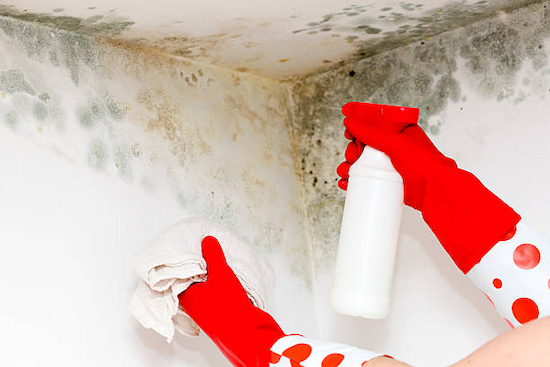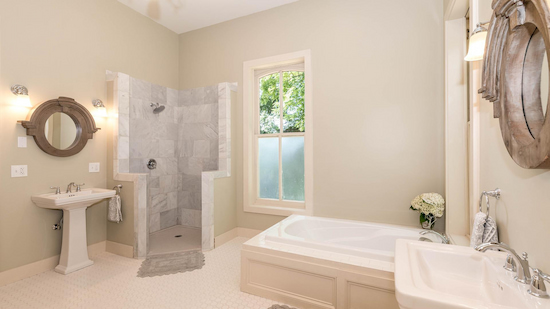Having moulds in your bathroom is a common occurrence, and there’s nothing to be ashamed of. It is common to find mould growth in walls, sealings, sealants, and other high-moisture locations. Mould thrives in various environments, and your bathroom is definitely not an exemption from that. But, there’s good news as there are a lot of things that can be done to fight the spread of moulds in your bathroom just by utilizing basic and affordable household cleaning products. If you’re still wondering how these can be possible, then definitely, you’ve come to the right place. For today, we’ll provide you with the ultimate guide on how to get rid of mould in bathroom!

- What Causes Mould?
- How to Remove Mold From Painted Walls?
- How to Get Rid of Mould in Bathroom Ceiling?
- How to Get Rid of Mould in Bathroom Sealant?
- Safety Warning When Getting Rid of Moulds
- How to Prevent Mold in Bathroom?
What Causes Mould?
Mould is a fungus that can turn out to be a challenging problem in your home, particularly in your bathroom. Mold in bathroom is not only unpleasant but can trigger a variety of health problems as well as structural damage to your house. But first, it’s necessary to understand what causes mould and how does mould grow, particularly in the bathroom? Mould replicates by releasing tiny spores into the air that we can’t see with our naked eyes. These spores are all around us and require the smallest quantity of wetness and moisture to replicate. Warmth likewise contributes to mold growth and will speed up the process. The mould in bathroom can appear within 48 hours of spores landing on a wet surface area at an ideal temperature for replication.
As we all know, heat and moisture exist greatly in the bathroom, which can cause a humid environment, a perfect breeding place for mould spores to begin to grow. This ideal environment is produced whenever you take a bath or wash your hands with warm water in the bathroom sink. Various microscopic dust and organisms in the air and on the surface areas in your bathroom then feed this bathroom mould, resulting in its fast replication.
How to Remove Mold From Painted Walls?
Mould in shower is an unhealthy and unsightly challenge that needs to be addressed as soon as you see it. The most common areas to find mould is on the tile grout and painted walls.
For mould on painted walls, try a natural eliminator like borax, white vinegar, and water mixture. You’ll also need a spray bottle together with other items to scrub the walls. Here are the steps on how to get rid of mould on walls permanently naturally:
- In a bowl, just mix two tablespoons of borax with 1/4 cup white vinegar and two cups of warm water.
- Put the mixture in a spray bottle.
- Freely use it on painted walls.
- Thoroughly scrub and wipe it clean, then spray again and let the mixture sit for 10 minutes before wiping it to dry.
How to Get Rid of Mould in Bathroom Ceiling?
The place over your shower is the most likely area to be the breeding place of moulds. As steam leaves the shower, it hits the cold ceiling and produces condensation. This wetness will later leak into the ceiling plaster and lead to mould spores.
If you already have mould on your bathroom ceiling, you can’t do anything but stop more mould build-up prior to cleaning what’s currently there. One of the best ways to remove mould from restroom ceilings is to utilize a simple warm water-detergent solution or a homemade cleansing solution out of diluted bleach or white vinegar.
- First, clean and wash the area with warm water and mild cleaning detergent. To utilize the bleach solution, mix one-part bleach with one-part water and use the solution with a fabric.
- If you want to opt for a more natural way to eliminate the mould. You might want to try utilizing the white vinegar by putting it into a spray bottle and spraying it straight onto the mould area.
- Through the help of a soft-bristled brush, scrub each line of grout on the ceiling to remove all the moulds. If there’s a remaining residue of the moulds, spray the location once again and scrub once again.
- After scrubbing, leave it for an hour or two, and then clean or wash the moulded area with water and wait for it to dry.
How to Get Rid of Mould in Bathroom Sealant?
Bathroom sealant is placed along the length of showers and sinks to avoid water from reaching the fixture. Given that it has a rubbery surface, a silicone sealant is a breeding place for mould.
Luckily, learning how to get rid of mould in bathroom sealant is not difficult as you just need some basic household items such as white vinegar, baking soda, a wet sponge, a moist rug, a stiff-bristled brush, bleach, and cool water.
- Through the use of 1 cup of white vinegar and 2-3 tsp of baking soda, mix it well to create a paste-like mixture.
- Make use of the wet/ damp rag to scoop out a small amount of the paste.
- Put a thick paste mixture over the sealant where the mould is.
- Leave the paste to sit for around 5-10 minutes.
- Make sure to use a stiff-bristled brush to scrub the paste away from the sealant to ensure efficiency.
- After scrubbing, use a wet sponge with cool water to clean the sealant.
- If the stains stay, just repeat steps 4-6 until no mould remains on the sealants.
- Ensure to kill any remaining mould spores with bleach and water and leave them to vaporize.
- Again, wash the area with a sponge and cool water.
- Finally, dry it with a clean towel.
- Remember to clean your bathroom frequently and ensure ventilation to avoid the reoccurrence of moulds.
Safety Warning When Getting Rid of Moulds
When you must remove mould concentrations or any black mould in bathroom, we recommend that you take special precautions due to the dangers of black mold in bathroom. You might want to not just avoid polluting the rest of the home but likewise protect yourself and your family from breathing high concentrations of VOCs and spores from moulds since prolonged exposure to black mould spores may result in respiratory problems such as asthma, lung and nasal passage bleeding, and other alarming concerns. Thus, the following tips might save you from these health hazards imposed by moulds.
- Use N-95 masks, in addition to safety glasses and gloves.
- Wear some of your old clothes and shoes that you can throw away after the cleaning process.
- Make sure to set an old box fan in a window to ventilate the room while working. Throw it out when it’s dry, as the spores of moulds can be impossible to wipe out. Tape cardboard around the window openings so the spores can’t be blown back.
- Shut off your heater and a/c, and cover ducts and doors to keep spores out of them.
- To control airborne spores, dampen moldy areas with a spray bottle while you work.
- Wrap, tape, and double-bag mold-infested debris in garbage bags for disposal.
How to Prevent Mold in Bathroom?

After you discover how to get rid of mould, the best defense is to prevent it from reoccurring in the future. The key to stopping these moulds is to control the moisture in your bathroom. The ideal breeding place for moulds is mostly in moist crawlspaces, in walls and attics where water has leaked in from the outdoors, and in basements with poor structural drainage. Ensuring excellent ventilation in attics, stopping these leakages, routing water away from the structure, and keeping crawlspaces dry are some of the best defenses to get rid of bathroom mould.
Did you know? Mildewcide in paint is surprisingly efficient for controlling bathroom mould, characterized by having moist areas. Many commercial paints currently have mildewcide in them. Thus, contact your paint dealer to be sure of mould elimination products.
Here are other tips that can save you a hefty amount of money on mould removal products while keeping your family and home safe:
- Use an exhaust fan when you take your shower and leave it on for 30 minutes following the end of your bath.
- Keep household humidity levels under 50% through the help of a dehumidifier or air conditioner.
- Make sure to use a mildew-resistant shower drape and wash it often.
- Never keep loofah, bottles of shower gel and hair shampoo in the shower, as they create places for mould to hide and replicate.
- And always remember to wash your bathroom rugs regularly to avoid a build-up of moisture.
Final Thoughts
If you are hesitant about whether there’s mould in your bathroom, you may opt to utilize a mould test kit for certainty. If the test outcomes are positive, then follow the list of tips and guidelines listed above to get rid of moulds in your bathroom walls, seals, sealants, and other high-moisture places.
Always check for the early signs of mould build-ups in your bathroom and apply what you understand in this article to get rid of mould in your bathroom. After you’ve successfully eradicated the mould, make sure that it won’t build up again by controlling moisture levels in your shower area. Remember that prevention is always the key to avoiding catastrophic events.
FAQ about How to Get Rid of Mould in Bathroom
It definitely looks gross, and it could be a cause for major problems. The majority of shower mold is just awful looking. However, it might pose a risk for people with respiratory issues and allergic reactions. Unknowingly, mold spores can become airborne and, when inhaled, can be hazardous to someone’s health. Truth to be said that shower mold probably will not kill you, but direct exposure can trigger you to have a cough, runny nose, and mild to moderate headaches. Thus, it is best to eliminate these molds in your living space.
I’m sure you’re wondering how to get rid of mold in shower with vinegar. Just use the basic and regular white distilled vinegar, generally with a 5% level of acidity, and it works best undiluted. So do not stress over mixing it with water first. However, due to the fact that it is a mild acid, avoid using vinegar on aluminium, waxed wood, natural stone, and cast iron, as it may cause damage to etching in the finish.
0 Comments for “Ultimate Guide on How to Get Rid of Mould in Bathroom”